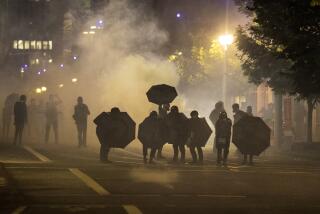New Protest in Soviet Georgia; Identity of Lethal Gas Sought
TBILISI, Soviet Union — About 3,000 people demonstrated here in the capital of Soviet Georgia on Tuesday as the republic’s health minister said he intends to force the military to reveal the type of poison gas used by troops to crush the April 9 demonstration in which 20 civilians died.
Tuesday’s protesters called for the release of leaders of political groups arrested after the April 9 clash.
It was the first demonstration in Tbilisi since troops charged into a crowd of about 10,000 staging a vigil with national flags and singing Georgian songs.
The latest demonstration was headed by Irakly Batiashvili, leader of an informal group seeking greater autonomy for the republic.
The protesters surged across the main Rustaveli Prospekt to lay wreaths. Some held aloft a banner demanding freedom for five other leaders of different organizations seized by military and Interior Ministry forces.
Minister’s First Priority
Minister of Health Irakly Menagarishvili told visiting foreign journalists: “Our first priority is to establish by chemical analysis the composition of the gas. The second is to force those who used the gas to reveal its chemical composition,” he said.
Doctors treating more than 60 people still suffering from the effects of gas poisoning have said they could not decide the correct treatment without knowing the name of the gas, which the military authorities have refused to identify.
Menagarishvili said most of those killed were women and that the deaths of two of them were directly attributable to a nerve gas similar to atropine, a poisonous chemical.
He said one of the 16 women who died was four months pregnant. Asked why so many of the victims were women and girls, Menagarishvili said it appeared that the gas was more harmful to women and children.
“It is also quite clear that the military personnel were given orders not to avoid women and children,” he added.
Witnesses interviewed in Tbilisi by the foreign reporters said those who tried to escape were hemmed in by tanks and personnel carriers and chased and beaten by the troops.
A nearby school was closed last week after a number of children fell ill from traces of gas from canisters fired into the building in pursuit of demonstrators, the minister said.
Toxicologist Zal Kakhiani, with the minister at the interview with foreign reporters, said that it was too late for the military to supply an antidote to the gas as such preparations were only effective in the first few hours.
He said there could be more deaths of gas victims in the months ahead from damage to the heart and central nervous system.
More to Read
Sign up for Essential California
The most important California stories and recommendations in your inbox every morning.
You may occasionally receive promotional content from the Los Angeles Times.










